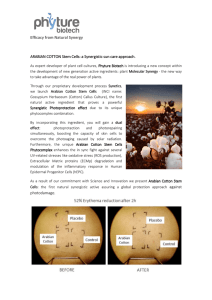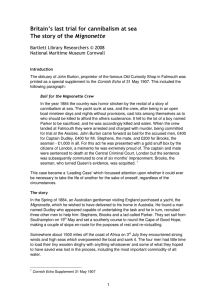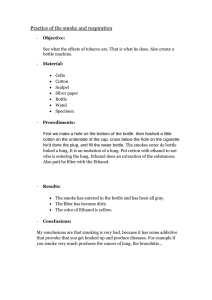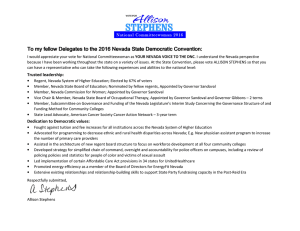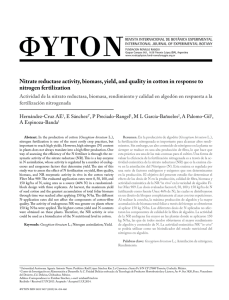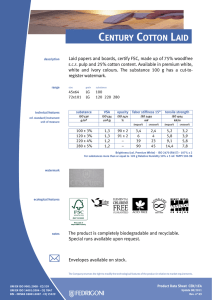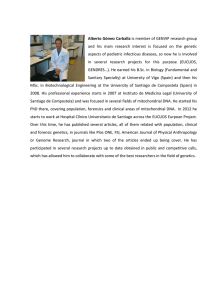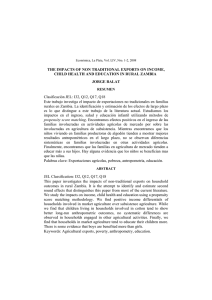stanley george stephens 1911–1986
Anuncio
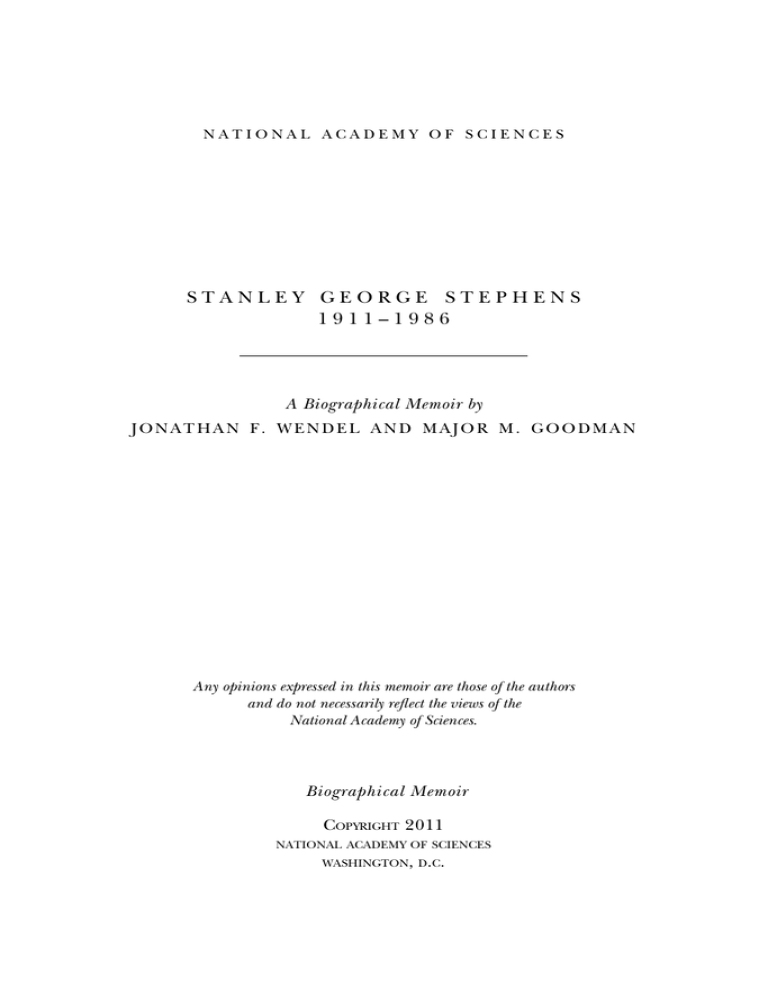
national academy of sciences stanley george stephens 1911–1986 A Biographical Memoir by jonAthan f. wendel and major M. goodman Any opinions expressed in this memoir are those of the authors and do not necessarily reflect the views of the National Academy of Sciences. Biographical Memoir Copyright 2011 national academy of sciences washington, d.c. STANLEY G e o r g e STEPHENS September 2, 1911–November 7, 1986 B Y JONATHAN F . WENDEL AND MAJOR M . GOODMAN M odern civilization and global agriculture depend on only several dozen of the world’s 300,000 or so species of plants. These key species, representing a mere handful of major grain plants and legumes, are largely responsible for the direct and indirect nourishment of the planet’s burgeoning population, supplemented by a short list of additional food sources and fiber plants. In spite of this reliance of civilization on our major crops, several thousands of years or more of domestication has so radically altered modern crop phenotypes that the taxonomic origins of many species has, until relatively recently, been obscure. This obscurity reflects, at least in part, the dramatic morphological transformations wrought by centuries of unwitting as well as conscious human selection. As Darwin noted in the introduction to his most famous book, the strong directional, diversifying, and purifying selection practiced by aboriginal and modern domesticators provides a powerful lens for understanding the workings of the evolutionary process. It is, therefore, of the highest importance to gain a clear insight into the means of modification… It seemed to me probable that a careful study of domesticated animals and of cultivated plants would offer the best chance of making out this obscure problem…[and that] imperfect though it be, B IOGRAPHICAL MEMOIRS of variation under domestication, afforded the best and safest clue. I may venture to express my conviction of the high value of such studies, although they have been very commonly neglected by naturalists. Thus, variation in crop plants and evolutionary analysis are intimately interconnected, providing the opportunity to study evolution on a telescoped timeframe, one in which both antecedent and descendant conditions remain extant, with the corollary that evolutionary investigation then becomes central to our understanding of crop variation, and by extension, agronomic improvement. This necessity of bringing a naturalist’s keen observational skills to bear on patterns of natural and humaninduced variation, within the intellectual framework offered by evolutionary theory, and then extending the knowledge gained into the realm of applied science, typifies some of the best plant biology in the last century; a leading practitioner of this paradigm was Stanley G. Stephens. For his seminal contributions to our understanding of the cotton genus, the domestication process, and for his fundamental contributions to evolutionary thought, Stanley G. Stephens is rightfully considered to be among the pioneers of modern, integrative crop plant genetics. EARLY YEARS, EDUCATION, AND FAMILY Stanley G. Stephens grew up in England, having been born in Worcestershire in 1911. The only child of an engineering draughtsman, his early interests included fishing and various athletic pursuits, primarily soccer and cricket. At the age of 17, while he was at high school (Brewood School), he noticed a classmate’s book on the subject of genetics, which he borrowed and apparently devoured, finding the subject fascinating. In an interview he gave to the Raleigh News and Observer nearly four decades later, in association with being stanley george stephens named the newspaper’s Tar Heel of the Week, Stephens said, “I read it and that was the beginning” (June 11, 1967). Having been admitted to St. John’s College at the University of Cambridge in November of 1930, Stephens continued to pursue an athletic life, becoming captain of the track team, where he particularly excelled in the long jump. He also became broadly trained in the natural sciences, specializing in chemistry, biology, and zoology and comparative anatomy, graduating with a natural sciences tripos (honors B.A.) in June 1933 and receiving a diploma in agricultural science in the spring of 1934. This breadth of training would later be philosophically highlighted by Stephens as critical, in his view, for the advancement of science (see below) and for science policy in the United States. Following his undergraduate education, Stephens was awarded a master’s degree from the University of Cambridge in February 1937. Subsequently he worked for a short time on a seed farm and then as a cereal breeder for the Scottish Society for Research in Plant Breeding in Edinburgh. For his doctoral work Stephens enrolled in the University of Edinburgh, receiving his Ph.D. in 1941; his doctoral dissertation was entitled “Studies of Yield Characters in Cereals with Particular Reference to Oats.” He met and married Dorothy Bolan in Edinburgh; they had two children, Dr. David B. Stephens, a heart surgeon, and Michael G. Stephens, a career employee of GlaxoSmithKline. ACADEMIC APPOINTMENTS AND ASSOCIATIONS In 1938, while Stephens was still a doctoral student, he found employment as an assistant geneticist at the Cotton Research Station in Trinidad, where he worked until it closed in 1944. Stephens avoided war service, perhaps because of his occupation as an agricultural researcher and the importance of cotton for clothing the military. Following brief academic B IOGRAPHICAL MEMOIRS appointments over the next few years at McGill University, the Carnegie Institution on Long Island, and Texas A&M University, Stephens joined the faculty of North Carolina State University in 1949. At N.C. State, Stephens enjoyed a 25-year career, serving first as a professor of agronomy, then as head of the Faculty of Genetics from 1951 to 1957, and retiring in 1974, 12 years prior to his death. In 1951 Stephens was among the three initial recipients of the William Neal Reynolds professorships, the most prestigious faculty rank available at N.C. State. Stephens and Dick Lewontin were the most prominent classical geneticists in the Faculty of Genetics at N.C. State, but the appointment of H. F. Robinson as head of the newly formed Department of Genetics in 1958 led to the dominance of quantitative genetics in the department for several decades. Lewontin left in 1958, and Stephens was one of the few attendees at Lewontin’s going-away party who was sufficiently sober to be able to drive home—the punch had been spiked with lab alcohol and there were bodies on the lawn the next morning. Stephens (along with Marcus Rhoades) was one of Barbara McClintock’s few confidantes in the period prior to her Nobel Prize. Perhaps as a result Stephens helped with the group of Robinson-recruited, largely Latino cytogenetics graduate students that William L. Brown and McClintock advised at N.C. State in the mid-1960s. Stephens could be quite social and helpful (while on sabbatical leave in Hawaii, he loaned his office to C. Clark Cockerham so that Cockerham could write N.C. State’s initial NIH quantitative genetics grant, which continued for decades and supported research across a half-dozen departments; the use of his cotton lab made the maize linkage studies of Goodman and Charles Stuber possible). But he was both private and resistant to needless paperwork. On one of the many, largely duplicate, forms that arose as a result of his various honorary recognitions, stanley george stephens he noted the multiplicity of the forms and proceeded to list his parents as Adam and Eve. The form was filed, and it isn’t apparent that anyone noticed the shortened pedigree. THE COTTON RESEARCH STATION IN TRINIDAD One of the watershed events in Stephens’s life was assuming a geneticist position in 1938 with a British cotton company, the Empire Cotton Growing Corporation, at the Cotton Research Station established in Trinidad in 1926. It was at this extraordinary facility that Stephens began his careerlong investigation of the cotton genus (Gossypium), setting the stage for several decades of landmark contributions. As a counterexample to the generality that geographic isolation hampers major advances in science, this secluded and remote research station in the Caribbean was remarkably influential and forward-looking. This is evidenced in prose taken from the announcement of its opening.1 The whole history of science shows that it is impossible to predict what results may emerge from any projected piece of work. Either on the main road, or on entirely unexpected by-paths, vantage-points may be reached from which a clear view is obtained of the country ahead, and though it is seldom that any direct short cut is discoverable. The dedication of a well-supported and robust scientific staff to problems that were not obviously agricultural in orientation was visionary, a point emphasized in the preface to Stephens’s landmark book, The Evolution of Gossypium (1947,2): “The adoption by the Empire Cotton Growing Corporation of the far-sighted policy which made possible the pursuit of fundamental botanical and genetic studies on cotton at the Cotton Research Station…” Although the extensive and foundational work accomplished by Stephens and others during his six immensely productive years at the Cotton Research Station was directed toward a comprehensive understanding of natural and genetic B IOGRAPHICAL MEMOIRS diversity, their research never strayed far from the recognition that their efforts would have applications of significance to agriculture, a legacy from which the world still benefits today. The goal of the Cotton Research Station was, after all, “provid[ing] an adequate foundation of knowledge for the proper planning of cotton breeding work.” In this respect Stephens was ideally suited to this research agenda, tracing to his broad education in the natural sciences and his doctoral degree in plant breeding. At the time the station was founded, only about 20 of the currently recognized ~50 species of Gossypium were known, and little was understood about cotton cytogenetics, genetics, evolution, and taxonomy. Even less clarity existed regarding the origin, human history, and patterns of diversity among the four different domesticated species, of which two (G. arboreum and G. herbaceum) are Asiatic diploids and two others (G. barbadense and G. hirsutum) are allopolyploids from the New World. The broad approach to science endorsed by the Cotton Research Station, combined with its ability to attract leading geneticists of the day (such as J. B. Hutchinson, A. Skovsted, and S. C. Harland, as well as S. G. Stephens) created a fertile environment for profound discovery, one that has had a lasting influence on our understanding of the genus and on modern evolutionary thought. The Cotton Research Station was closed near the end of World War II, an event captured in the full title to Stephens’s 1947 book, The Evolution of Gossypium and the Differentiation of the Cultivated Cottons, Being the Final Report of the Genetics Department of the Cotton Research Station, Trinidad, B.W.I. Much of the ongoing work in Trinidad was transferred to Uganda, but the expertise concentrated at the Trinidad station was never duplicated. Stemming in part from the work of Stephens and his colleagues in Trinidad, Gossypium now is among the better understood crop plant genera; it serves as a model system for explorations of the stanley george stephens important phenomenon of allopolyploid speciation and for studies of evolution under domestication.2 The Evolution of Gossypium and the Differentiation of the Cultivated Cottons is a relatively short book (141 pages of prose, with an additional 20 pages of references and an index), but it is one that provides an abstract of the state of knowledge at the time about diversity and evolutionary processes in Gossypium, with separate sections on the classification of the genus, evolution of the wild species, and “differentiation of the true cottons,” the latter detailing patterns and distribution of genetic diversity within each of the four domesticated species. The final 30 pages are devoted to “the significance of Gossypium in evolutionary studies,” and highlight, among other things, the prospects for evolutionary innovation due to allopolyploidy and the significance of this vis-à-vis crop improvement. In reading the text one cannot help but be impressed by the integration of disparate sources of evidence in reaching scientific conclusions, including ecology, fundamental plant exploration and taxonomy, physiology, and genetics, and the efforts of the authors to weave these disparate threads into a fabric that supported scientific insights as well as efforts to enhance cotton-breeding efforts. Commenting frequently and perhaps precociously on the benefits of interdisciplinarity, Stephens and his coauthors reached the prescient conclusion, now taken for granted almost universally, that “the crop biology of the future will be a single science, and its success will be in proportion to the degree in which specialist studies are made to serve the need of coordinated research.” FROM TRINIDAD TO NORTH CAROLINA The closure of the Cotton Research Station in Trinidad led Stephens to seek employment elsewhere and, as summarized above, ultimately landed him in Raleigh in 1949, where 10 B IOGRAPHICAL MEMOIRS he spent most of his career. During this transition period Stephens focused on analyzing and publishing much of the data generated while in Trinidad. There Stephens had access to extensive collections of wild species as well as the myriad forms of the domesticated cottons, the latter represented by truly wild types, “race stocks,” “dooryard” collections, and feral accessions. Later he collected many more of these himself, beginning in 1946 in Central America, and eventually from throughout the extensive and overlapping geographic ranges of the domesticated species, particularly for the two New World allopolyploids, G. barbadense (Egyptian, Sea Island and pima cotton) and G. hirsutum (upland cotton), now comprising about 90 percent of the global cotton market. These accessions, some of which were collected in collaboration with the eminent tomato geneticist and academy member Charles M. Rick Jr., comprised a vast collection of natural variation and mutants for Stephens to study. In fact, this approach—that of keen observation combined with precise genetic analysis of extensive natural variation—is a recurring theme in Stephens’s science, characterizing most of his key discoveries. Having access to the diploid and allopolyploid species known at the time, Stephens became attracted to the longstanding problem of the timing of origin and parentage of the New World allopolyploids that earlier had been shown to carry two genomes (A and D) that occur in diploid species groups (termed A-genome and D-genome) that presently occupy different hemispheres (Africa and Asia, and the New World, respectively). Stephens studied this problem extensively, using cytogenetic and genetic methods, studying chromosome behavior in a multiplicity of interspecific and intraspecific combinations and the segregation and expression of alleles (particularly leaf shape alleles) when transferred across species boundaries. In addition to clarifying aspects stanley george stephens 11 of the phylogenetic history of Gossypium and the origin of the allopolyploids (1944; 1947,1; 1949,1), this work led to an important paper on the significance and meaning of polygenes and modifiers in evolution (1945). In the latter paper Stephens summarized a portion of his work on leaf-shape alleles and their developmental trajectories, highlighting differences in expression patterns and genetic segregation in the backgrounds of different species, as well as the relevance of these data for understanding evolutionary patterns. Perhaps as a result of this careful study of broad patterns of natural variation and genetic analysis of the interspecific expression of particular genes in different backgrounds, Stephens also made the profound discovery of the evolution of a form of hybrid dysgenesis, or hybrid necrosis (in modern parlance), operating in G. barbadense and G. hirsutum (1946; 1950,1). In this system certain interspecific hybrids of the two species exhibit a complex of abnormalities, including female sterility, stunted growth, and excessive protrusions emanating from the cork cambium. Stephens showed that this phenotype is conditioned by two normally rare and recessive alleles at the corky locus, ckX in G. hirsutum and ckY in G. barbadense, and moreover, that these rare alleles reach their greatest frequencies precisely in areas in the Caribbean where the two species come into close contact due to joint cultivation. Stephens postulated that the phenotype and geographic distribution of the carrier alleles could only be explained by invoking selection for reproductive isolation. In the latter of these two papers Stephens provides evidence that this may be a common form of reproductive isolation in plants, citing examples from Crepis and Triticum/Aegilops, and presenting the case that the underlying genetic basis of this evolutionary phenomenon involves pseudoalleles, or what we would now recognize as local tandem duplications. 12 B IOGRAPHICAL MEMOIRS AT NORTH CAROLINA STATE UNIVERSITY One of Stephens’s most lasting influences has been on how gene and genome duplications are viewed and in particular their role in evolution. In opposition to the prevailing wisdom of some leading evolutionists and systematists of the era who believed that polyploidy was mostly an evolutionary dead end, Stephens emphasized the creative role that polyploidy plays in plant evolution. As early as 1947 Stephens and colleagues wrote that among crop plants polyploids possess the characteristics of high variability, extensive differentiation from their wild prototypes, and great range and adaptability, that are usually associated with evolutionary success, and it is here suggested that far from being variations of no long-term significance, they lie on a main line of evolutionary advance. (1947,2; pp. 116-117) Stephens’s keen observational skills and interest in the remarkable diversity that exists in Gossypium, as well as his early interest in the parentage and timing of the origin of the allopolyploid cottons, set the stage for detailed explorations of diversification of function in genes that become duplicated by polyploidy (these are termed “homoeologs”). Recognizing that Gossypium offered an excellent system to study the differences between homologous genes in diverged diploids, as well as their corresponding homoeologs in allopolyploids, Stephens (1951,1) asked, What happens to a genetic locus after it has become duplicated as a result of amphidiploidy? Does it retain the same potentialities possessed in the diploid parent? Are its mutants of the same type? …Has anything radically new been added to the ancestral system? Using careful genetic analyses of the Cluster (Cl) and anthocyanin (R) loci, Stephens demonstrated the evolutionary possibility of duplication-induced innovation (neofunctionalization) in the case of Cluster, noting that “duplication may introduce new possibilities of recombination: by crossing stanley george stephens 13 over in the case of a repeat, by independent segregation in the case of chromosomal reduplication.” With respect to the anthocyanin locus, Stephens was perhaps the first to generate actual data that demonstrate sub-, or perhaps nonfunctionalization, writing, “The ‘homologous’ loci in the sub-genomes of the amphidiploids are appreciably less complex, and it seems more likely that these represent secondary simplifications.” These results were elaborated in a more extensive synthesis entitled “Possible Significance of Duplication in Evolution” that Stephens wrote for Advances in Genetics (1951,2), where he reviewed possible cases of functional divergence between duplicated genes, parsing these into duplications on different chromosomes (including homoeologs) and those that are tandem, or pseudoallelic. Citing meticulous genetic experiments in cotton supplemented by examples from the literature, Stephens prophetically commented, two decades before Ohno’s classic book Evolution by Gene Duplication,3 that it is a reasonable assumption that in newly formed amphidiploids numerous loci must be duplicated and that any subsequent disappearance of duplicate functions must be attributed to (a) loss or inactivation of one of the loci or (b) divergence in function [and that] theoretically, duplication of loci would appear to offer a means of gaining a new function without losing the old one. Recognizing the difficulties inherent in proving acquisition of function, Stephens reviewed possible cases known at the time but recognized that definitive proof of what we now call neofunctionalization had yet to be obtained. He speculated (1955,1) that many of the recessives in allopolyploid cotton observed today represent just such cases. Stephens had an abiding interest in mechanisms of speciation (teaching an advanced graduate course on the subject for many years), and in particular the roles played by gene and genome differentiation in evolution. This theme is apparent throughout his career, as reflected in 14 B IOGRAPHICAL MEMOIRS his interest in divergence and loss among gene duplication caused by polyploidy, his discovery (discussed above) of the corky system of reproductive isolation, and in long-standing interest in patterns of interspecific distributions of alleles. It also is apparent in his extensive writings on the phenomenon of “cryptic structural differentiation” (1949,2; 1950,2; 1961,1), a phenomenon invoked to account for the aberrant segregation ratios, donor parent elimination, and reduced crossover frequencies observed in interspecific progenies. He promoted the view that the build-up of these cytogenetically cryptic structural changes was important during speciation, augmenting differences that arise between species due to divergence among homologous alleles: “The general conclusion to be reached from these studies is that both multiple gene substitution and cryptic structural differentiation have determined the building of species from the earliest stages onward.” Stephens’s research on species differences and his long experience with interspecific genetic manipulations led him to consider the role of interspecific hybridization in cotton improvement, an interest tracing to his early training as a plant breeder and his concern for transferring basic scientific understanding into agronomic advances. Notably, the first paper ever published in the journal Crop Science was entitled “Species Differentiation in Relation to Crop Improvement” and it was authored by S. G. Stephens (1961,2), following its presentation as an invitational address at the 1959 meetings of the Crop Science Society of America. Noting that interspecific hybridization was one of “the most promising and at the same time frustrating tools available to the plant breeder,” Stephens brought perspectives enabled by his work on recombination, donor parent elimination, cryptic structural differentiation, and linkage compensation (1961,1) to bear on issues confronting the interspecific transfer of stanley george stephens 15 traits. He concluded by calling for increased research on the problem of introgression in experimental populations. As noted above, Stephens moved fluidly between the worlds of the natural historian interested in documenting and understanding patterns of variation, the geneticist focused on inheritance and evolutionary significance, and the plant breeder having applied objectives. With respect to natural history, Stephens was enamored of the extensive variation that occurs among populations and races of the allopolyploid cottons, the myriad forms of which are found throughout Mesoamerica and the Caribbean, as well as on far-flung islands in the Pacific. He traveled extensively on plant exploration expeditions, using the mechanism of Guggenheim fellowships and other opportunities, collecting many hundreds of accessions from large parts of the geographic ranges of most of the allopolyploids, particularly the two domesticated species. This work, the legacy of which is intact today and represented by numerous accessions in the National Collection of Gossypium Germplasm maintained by the U.S. Department of Agriculture in College Station, Texas, led to keen insights on polymorphic genetic systems and their use in understanding phylogeny (1972; 1974,1,2) provided a natural collection of mutants for genetic studies throughout his career (tracing to his years in Trinidad), and led to a vastly enhanced understanding of the ecology of wild and feral allopolyploid cotton. Stephens became fascinated by the problem of seed dispersal, publishing widely (1958,1,2; 1963; 1966) on experiments and observations bearing on the question of how relatively young lineages might achieve such an enormous aggregate geographic range. He commented widely and insightfully on such topics as the origin of the Hawaiian Islands’ endemic G. tomentosum, the possible role played by Polynesian cultures in allopolyploid formation and dispersal, the potential involvement of abiotic (e.g., ocean 16 B IOGRAPHICAL MEMOIRS currents) and biotic (e.g., birds) factors in seed dispersal, and the later superimposed effects of dissemination by European colonists. Among all of his other talents Stephens was an outstanding natural historian and intuitive ecologist. The question of dispersal and colonization of the New World tropics, or at least their littoral environments, was partly motivated by a desire to understand the history of domestication in cotton, which required careful thought about the traits that distinguish wild from domesticated cotton and how these best might be illuminated and analyzed. Stephens addressed this topic in two key papers (1958,1; 1967), laying out clearly the arguments for human modification of traits of plant habit, flowering and fruiting characteristics, seed germinability, and fiber morphology. This interest led naturally to an allied curiosity regarding archaeological cottons, as reflected in his 1973 paper in Science (among others) on early archaeological findings from Peru. HONORS AND AWARDS Given the foregoing synopsis of Stephens’s extensive scientific achievements and their relevance to cotton improvement, it is not surprising that he received widespread recognition in the academy and beyond. In 1951 he was appointed as a William Neal Reynolds Professor at North Carolina State University. In 1962 the National Cotton Council and the Cotton Breeding Industry gave Stephens the nation’s top award in his field, the Cotton Genetics Award, for his numerous and diverse contributions to science. In recommending him for that award, Harvard University scientist Paul C. Mangelsdorf called Stephens “the most distinguished cotton geneticist in the U.S. and, among now-active geneticists, the most distinguished in the world.” Stephens was elected to the National Academy of Sciences in 1967, becoming the first such member on the N.C. State faculty. Later that same stanley george stephens 17 year the Raleigh News and Observer selected Stephens as Tar Heel of the Week. Stephens also was a 1968 recipient of the North Carolina Medal, awarded by the Governor of the state. In 1970 he received the O. Max Gardner Award, an honor established by the late Governor Gardner in his will, to be awarded to a professor at any of the then six campuses in the state system “who has made the greatest contribution to the welfare of the human race.” In his acceptance speech Stephens returned to his career-long emphasis on the importance of interdisciplinarity and of breadth in scientific training and approach, commenting that “we must find a means of striking a balance between depth and breadth of knowledge. I think, too, that we are presently out of balance; that breadth has been sacrificed for depth.” A similar perspective is in evidence in the Congressional Record of the United States Senate (Oct. 11, 1967) in the form of a letter from Stephens (dated Aug. 24, 1967), addressed to Senator Edmund S. Muskie, in support of Senate Resolution 68 for the establishment of a Select Senate Committee on Technology and the Human Environment. He wrote, You invited me to express any comments or suggestions connected with the proposed legislation. My chief comment, I am sure, must have been made previously by many scientists: it is the problem of dwindling communication which accompanies specialization in rapidly evolving areas of research…and a young man entering these fields achieves this mastery by sacrificing breadth in education. Consequently the total area of science today is becoming occupied not by an “integrated” population of scientists but by a collection of individually segregated groups…There is a problem then in achieving perspective; in distinguishing between fundamental growth and bandwagon expansion; in deciding between the relative advantages of rapid short-term gains and long-term slow accretions. It seems to me that the recognition of this and other general problems, and the setting-up of machinery to study them is very pertinent in our times. Many who might read these words would likely find them equally pertinent today. 18 B IOGRAPHICAL MEMOIRS THE STEPHENS LEGACY Stanley Stephens’s contributions and accomplishments reverberate in multiple arenas today. Many of the materials and populations that he collected remain important sources of germplasm in many research programs, finding uses in comparative studies of domestication, speciation, and polyploid evolution. Through these materials and their analysis, he has left a lasting legacy for cotton crop improvement and our fundamental understanding of the cotton genus, patterns of diversity in the cultivated species and how these have been shaped by humans, and plant evolutionary genetics in general. Tracing in no small measure to Stephens’s efforts, Gossypium is now among the best models for domestication and allopolyploid speciation. In this centennial anniversary of Stephens’s birth it is notable that Stephens was cognizant of posterity, as is true for most scientists who recognize the grand sweep of scientific history and the limitations and possibilities for a single person to advance scientific understandings. In the box of reprints he left at North Carolina State University shortly before his death, he included a handwritten note on a now-yellowed piece of 5x7 inch paper, dated Feb. 8, 1984, in which he wrote just two simple sentences: “At my death, these reprints should be offered to N.C. State Univ library (D. H. Hill). If, as I expect, they will not be of sufficient interest, they should all be destroyed (1941 through 1970s inclusive).” Clearly, Stanley G. Stephens’s prognostication skills were no match for his scientific prescience, although it was almost 25 years after his death before library personnel decided there might be value in those papers, and hence added them to the archives collections. stanley george stephens 19 NOTES 1.J. B. Farmer and L. G. Killby. British cotton research in Trinidad. Report of the Empire Cotton Growing Corporation. J. Hered. 16(1925):375-377. 2.J. F. Wendel, L. E. Flagel, and K. L. Adams. Jeans, genes, and genomes: Cotton as a model for studying polyploidy. In Polyploidy and Genome Evolution, eds. P. S. Soltis and D. E. Soltis. New York: Springer, 2012. 3.S. Ohno. Evolution by Gene Duplication. New York: Springer-Verlag, 1970. 20 B IOGRAPHICAL MEMOIRS SELECTED B I B LIOGRAPHY 1944 Phenogenetic evidence for the amphidiploid origin of New World cottons. Nature 153:53-54. 1945 The modifier concept. J. Genet. 46:331-344. 1946 The genetics of corky. I. The New World alleles and their possible role as an interspecific isolating mechanism. J. Genet. 47:150-161. 1947 [1] Cytogenetics of Gossypium and the problem of the origin of New World cottons. Adv. Genet. 1:431-442. [2] With J. B. Hutchinson and R. A. Silow. The Evolution of Gossypium. London: Oxford University Press. 1949 [1] Genome analysis in amphidiploids. J. Hered. 40:102-104. [2] The cytogenetics of speciation in Gossypium. I. Selective elimination of the donor parent genotype in interspecific backcrosses. Genetics 34:627-637. 1950 [1] The genetics of corky. II. J. Genet. 50:9-20. [2] The internal mechanism of speciation in Gossypium. Botan. Rev. 16:115-149. 1951 [1] “Homologous” genetic loci in Gossypium. Cold Spring Harb. Sym. 16:131-141. [2] Possible significance of duplication in evolution. Adv. Genet. 4:247-265. 1954 Interspecific homologies between gene loci in Gossypium. I. Pollen color. Genetics 39:701-711. stanley george stephens 21 1955 [1] Summary, synthesis and critique (of the Symposium: Pseudoallelism and the Theory of the Gene). Am. Nat. 89:117-122. [2] Linkage in upland cotton. Genetics 40:903-917. 1958 [1] Factors affecting seed dispersal in Gossypium and their possible evolutionary significance. N. C. Exp. Sta. Tech. Bull. 131. [2] Salt-water tolerance of seeds of Gossypium species as a possible factor in seed dispersal. Am. Nat. 92:83-92. 1961 [1] Recombination between supposedly homologous chromosomes of Gossypium barbadense L. and G. hirsutum L. Genetics 46:1483-1500. [2] Species differentiation in relation to crop improvement. Crop Sci. 1:1-5. 1963 Polynesian cottons. Ann. Mo. Botan. Gard. 50:1-22. 1966 The potentiality for long range oceanic dispersal of cotton seeds. Am. Nat. 100:199-210. 1967 Evolution under domestication of the New World cottons (Gossypium spp.). Cilncia e Cultura 19:118-134. 1972 With L. L. Phillips. The history and geographical distribution of a polymorphic system in New World cottons. Biotropica 4:49-60. 1973 With M. E. Moseley. Cotton remains from archaeological sites in central coastal Peru. Science 180:186-188. 22 B IOGRAPHICAL MEMOIRS 1974 [1] Geographic and taxonomic distributions of anthocyanin genes in New World cottons. J. Genet. 61:128-141. [2] The use of two polymorphic systems, nectary fringe hairs and corky alleles, as indicators of phylogenetic relationships in New World cottons. Biotropica 6:194-201.
